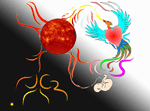« There is always, in our childhood,
a moment when the door opens and lets the future in. » Graham Greene. |
The birth
of the healthy mind.
of the healthy mind.
We know that the foetus can react to sound and light, but it is difficult to know how conscious a child is before birth. Bathed in maternal hormones, we can imagine that its perceptions are influenced by those of its mother, and that it feels the same emotions, without however perceiving and understanding their origin.
We have envisaged that the perceptions of the foetus, before birth, may reappear in NDEs, where the adult subject contacts a universal, fusional love... They also seem to reappear in certain states of "vacuity" induced by meditation in which welcoming listening, without judgement, replaces permanent reflection.
Even if it is not conscious in the sense that we understand it, the baby certainly has perceptions of itself and, through maternal hormones, perceptions of what its mother is feeling or experiencing.
It is at birth that he will experience a major event : his whole environment will change. Separated from a world in which he lived in a state of fusion, he will have to reorganise all his perceptions and discover his place in a world that is so different from his own.
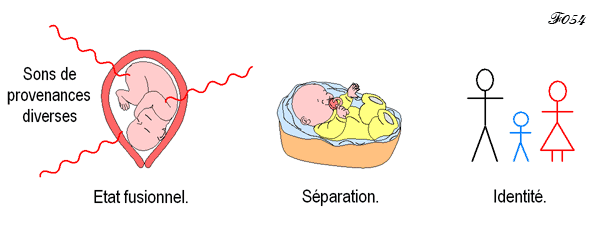
Thanks to vision, he will then apprehend the outside world and distance, which will gradually enable him to distinguish between himself and the world and then between himself and the other... After having become aware of the other and his appearance, he will become aware of his own appearance.
We know that there are mirror neurons in the brain that are activated in the same way when the child sees or reproduces the gesture observed.
As soon as the baby is able to see, it will demonstrate its imitation abilities. Thus, from birth, and after only 42 minutes, it shows itself capable of imitating a facial expression : in doing so, it demonstrates its ability to perceive the similarity between its face and that of another.
In the early 1980s, the work of Andrew Meltzoff, a child development psychologist at the University of Washington, showed that infants have an innate ability to recognise that another person is similar to them : they can therefore reproduce the expressions of the face facing them.
If you stick out your tongue, he will stick it out. If you open your mouth wide, he does the same.
Already, thanks to this capacity for resonance, a whole part of the future adult's personality is being established. Indeed, every normally constituted person resonates with others. This is how the adult confronted with expressions of anger towards him or her will feel the need to react in the same way. This is not the same as empathy, because empathy allows us to feel without experiencing the same anger or resentment.
In babies, this ability to reproduce the movements or expressions of those around them is not intentional, but automatic : this is called motor resonance (in french).
Babies, on the other hand, do not react when they hear the complaints of a small chimpanzee ; we can therefore assume that they already know how to identify with another baby when it cries, or with an adult when it imitates its mimics.
Similarly, they do not react when they listen to their own recorded cries. Emotional resonance is therefore only between oneself and the other.
At two months, for the perception of faces, the infant activates the same region in the right hemisphere as the adult : the right fusiform gyrus and the inferior occipital cortex.
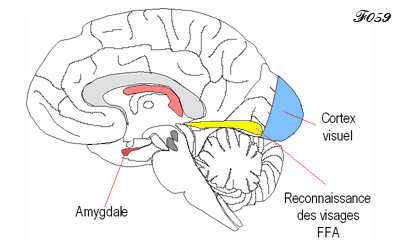
From the age of three months, the language areas located in the left hemisphere are activated when listening to sounds and stories.
Thus, soon after being able to recognise expressions on faces, the infant will start to establish a link between what is shown to him (objective reality) and what is verbalised (virtual reality). Vision and hearing will coordinate to enable communication.
At four months of age, the child knows that an object continues to exist when it disappears from the visual field. However, he expects the object to reappear where it disappeared.

b - Emotions :
Paul EKMAN, professor of psychology at the Department of Psychiatry of the University of California, has listed the following elements to determine the basic emotions.
For him, each one must :
- be associated with triggering events,
- appear spontaneously, quickly,
- be evaluated automatically,
- be expressed by physiological changes,
- involve specific images, thoughts or sensations,
- be present not only in humans but also in other primates.
All these criteria enabled him to retain only six basic emotions, each associated with a facial expression : surprise, joy, sadness, anger, disgust and fear
These six basic emotions have, of course, been identified regardless of human group or culture.
The newborn baby is also capable, within hours of birth, of reacting to different adult emotions and of displaying its own emotional reactions.
The precociousness of this behaviour, which is not the result of learning, shows that the expression of these emotions seems to be innate.
Charles Darwin, in 1872, had already tried to find out whether human facial expressions were dependent on cultural influences or whether they were determined by biological factors. For him, not only was the expression and perception of emotions innate, and universal, but the way in which faces express anger, fear or disgust was identical in hominids, such as humans and apes.
Thus emotions, because of their precociousness and their presence equivalent to a universal language, indicate that before being designed to reason, the human brain is designed to act, with the emotions it arouses serving to transmit information for this purpose.
How do these emotions develop ?
When we observe newborns imitating their surroundings, the first question that arises is : do newborns feel what they are expressing ?
We then observe that, as early as six weeks, babies unanimously react negatively to the "stillface" test (impassive, fixed face, even smiling).
Indeed, if the eyes do not react, it is not a smile of joy or pleasure, but a smile of convenience that can be found, for example, in the field of sports dancing where it is important to give the illusion of pleasure.
When the mother is shifted in this way, babies always show eye avoidance and emotional upset. Conversely, if the smile is natural, the two-month-old baby reacts with a smile, proof that it is neither imitation nor chance. He knows how to recognise the real from the fake.
It is therefore at this age that the true function of communicating emotions appears.
Later, between four and six months, the whole body will participate in the emotion.
Finally, between nine and twelve months, the baby begins to understand that facial expressions convey information about the context. The child will then rely on the mother's expression to explore the environment.
c - Calculation :
Jean William Fritz Piaget, and Szeminska considered that the concept of number is acquired in the child around 6 or 7 years, with the acquisition of the notion of conservation.
In 1992 Karen Wynn developed an experimental procedure based on babies' interest in novelty, the habituation paradigm. She was able to show that at around four months of age, they show rudimentary numerical abilities.
d - Attitudes :
At around 4 to 6 months, the baby identifies attitudes and behaviours that differ between people. This differentiation is the first step in his own identification with others.
He is thus able to spot emotional reactions even before recognising each person individually.
This is different from the adult who recognises appearance before emotional expression.
At 8 months, the infant distinguishes familiar people from others
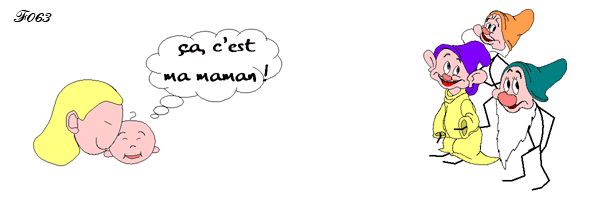
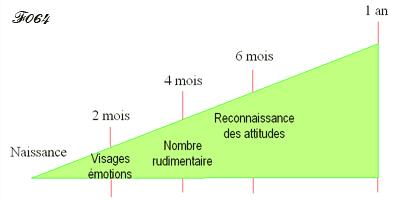
We have seen that before the age of one, a child looks for an object where it is at the beginning, even if he has seen an experimenter change its place. He then recognises an object fixed in the present moment : his memory does not yet allow him to situate this disappeared object in the past.

It is only from the age of one that he will discover that the same object can change place. He will thus learn that things are not immutable.
He then begins to correct his error of location, which also corresponds to the integration of a new data in the cerebral functioning : the chronology.
Indeed, the change of position of an object implies, in addition to the integration of the notion of space, that of the notion of time. There is before and after. The two are not identical.
The object can be there or elsewhere, but never there and elsewhere at the same time. Between the two, there is the memory of the object's previous place.
The memory, which was previously content to store new information, will now organise itself to fix in a data bank the events or objects that no longer exist in the present.
A piece of information perceived and fixed at the beginning (the object is on the table) will be erased while another piece of information, secondary at the beginning (the object was put on the chair) will be reinforced..
The memory begins to structure the unfolding of time : it expresses another past time that is not in contradiction with the present, but completes it.
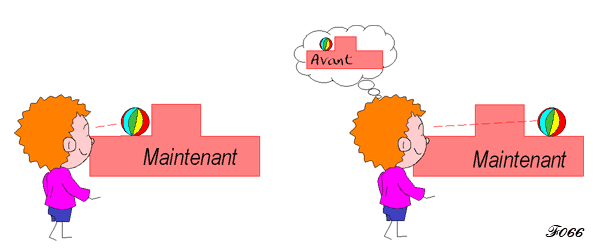
This mechanism shows the appearance of a new function which consists of inhibiting a certainty (the object is there) to situate it in another time (it was there): this corresponds to the beginning of the maturation of the prefrontal cortex and the structuring of its memory which passes from analogical processing to cognitive processing [cf : Les prémices de la conscience / La mémoire-(in French)].
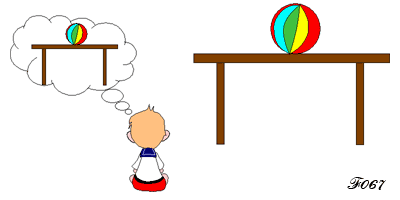
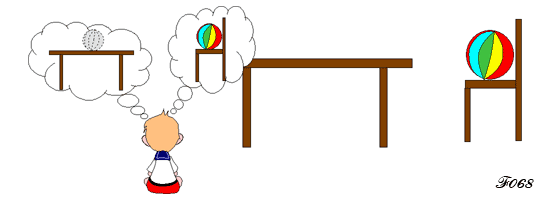
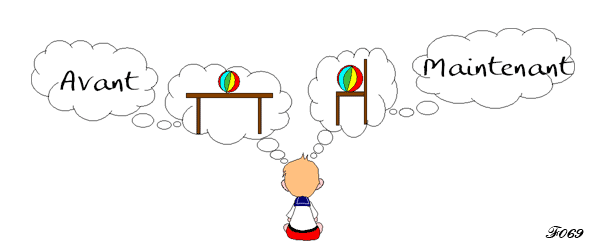
b – Calculation :
In this area, performance is improving, but he still makes mistakes, such as confusing length with number when estimating a quantity.
c - Differentiation and self-awareness :
Around 18 months, the child is able to distinguish himself from others. After having learned to reproduce their gestures and their mode of communication, he discovers that he can also have an effect on his environment.
But let's take a closer look at what happens during this period.
Before birth, the child's consciousness was dependent on its own perceptions : first of all, those of contact, but also those of the distant world that reached it from outside the uterine wall (digestive sounds) or from outside its mother's body (music). In this way, he had learned to differentiate between pleasant and unpleasant sounds (soft music lulls the mother and child to sleep, screams that stress the mother also disturb him), but he had certainly not been able to understand their origin.
The outline of consciousness developed during pregnancy, from the four senses preceding the use of vision, has forged an archaic personality dependent on the immediate environment.
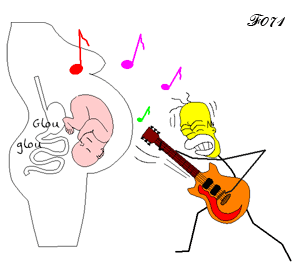
After birth, the use of sight will enable him to discover the world at a distance, and to structure himself by differentiating himself from the surrounding world.
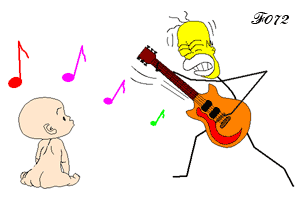
Indeed, the acquisition of vision gives the necessary distance for identification, and the coordination of the different senses will make him aware of his existence (there is the other, I see him, hear him and can touch him, and there is me, I feel myself, I hear myself speak, and I can touch myself).
18 months marks a new stage in the child's development.
While the child has come to know its parents before 18 months, its personal identification is not yet complete.
Thus, children under 18 months of age, when placed in front of a mirror, touch it or try to see the figure that appears to them through the glass. It is beyond this age that the child, having grasped what a mirror is, recognises his own image in it.
He has begun by discovering the surrounding world, then discovered the other, and what differentiates him from it. He now distinguishes himself from others : his individuality is transformed into social identity.
d - Empathy :
14 to 18 months :
The child's ability to imitate will be coupled with another ability, that of feeling what the other person is feeling : this is what is called empathy... The child now perceives this subtle nuance : although others are people like him, they are different and do not necessarily want the same things.
Thus, before the age of 18 months, if the child thought that his parents had the same desires and tastes as him, his social maturation will now allow him to offer them the food they like, even if this choice does not correspond to his own tastes.
Empathy replaces resonance. By enabling the child to distinguish between what others and the child feel, it is seen as a key element of development.
It requires differentiation from others and reveals an awareness of one's own identity, different from that of the other. Thus, the child has become capable of perceiving the pain of the other, but without suffering like him !
What the other person feels and expresses through their attitude or facial expression will activate their mirror neurons and enable them to feel: gesture and perception are closely linked.
The child now possesses this link that many adults have lost [cf : Intuition] (in french).
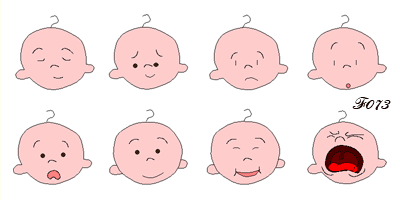 His brain (anterior insula, and cingulate cortex) reacts well to the pain of others, but he does not feel it, which appears in brain imaging where the extent of neuronal activations is less important in the case of empathy.
His brain (anterior insula, and cingulate cortex) reacts well to the pain of others, but he does not feel it, which appears in brain imaging where the extent of neuronal activations is less important in the case of empathy.
With empathy, a whole set of emotions and social behaviours develops: comfort, shame, pride, help, distrust, guilt... It indicates the maturation of the functions of the frontal cortex in relation to the social environment.
Empathy is important for life in a hostile environment, where it is necessary to protect oneself, and it is equally important for life in society, because it leads to helping others.
This mechanism will take almost four years to become functional. During this period, the child will explore his or her relationship with others and refine his or her perception of the interiority of others.
 e - Emotions :
e - Emotions :
The maturation of emotions continues :
At around four to five years of age, the child knows that one can feel emotions and not show them or, conversely, that one can be betrayed by one's facial expression.
He then moves from imitating mental states to manipulating them.
As he grows older, he learns to inhibit spontaneous emotional responses, and to become less natural. Paradoxically, the more he enriches his emotional capacities, the less he will share his emotions.
f - Language :
We have seen that even before understanding abstract language, the child is able to understand body language. The general attitude and facial expression therefore appear to be the first elements of language before words replace the image.
We also know that the effort of attention can only be focused on one event at a time [cf : the work of consciousness during the awakening (in french)].
We can therefore already imagine that with the appearance of verbal language, the child could forget the visual expression and, sometimes, no longer take it into account [cf : Intuition (in french)].
Thus, the learning of verbal language could be the first step of the little man towards the loss of the understanding of body language... as, later, the adult could lose the understanding of his dreams [cf : REM sleep and language (in french)].
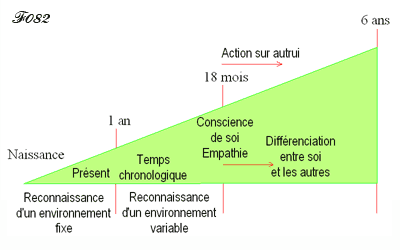
This is when a new stage in the child's developmental process takes place, which will allow him to integrate even more closely into the human family, with consequences for his individual developmentl...
During this period, the child's individual mode of functioning in relation to the environment begins to be repressed. The "age of reason" begins to take hold.
Generally speaking, whereas in the previous period certain areas of the cortex became thinner, indicating the suppression of cells that had become useless, other areas will now predominate (prefrontal cortex) and become thicker.
This is how we can observe the thickening of the grey matter in the so-called "associative" areas of the prefrontal cortex, the superior temporal cortex and the parietal cortex, which manage the higher cognitive capacities.
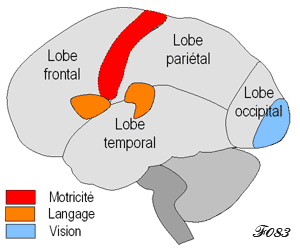
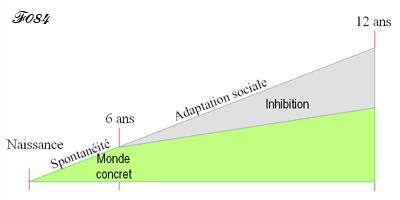
b - Numbers :
- At age 6, the child acquires numbers (according to Piaget) : he moves from innate perception to abstract calculation.
This acquisition cannot take place without inhibition : in fact, in order to carry out measurements, the child must first inhibit his innate perceptions.
Numbers, in their multiplicity, dissociate the child from his natural capacity to evaluate quantities, a capacity that we find in primitive peoples who know how to count from one to three, the higher numbers being limited to the notion of « many ».
Recognition of the environment is refined : the child becomes able to inhibit erroneous perceptual strategies, such as deducing that a row of chips (tokens) contains more chips if it is longer..
He now recognise that two rows contain the same number of chips (tokens) even though they are different lengths. Moves from "estimating" a value to "calculating" that value.
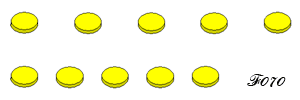
It is interesting to note that the acquisition of precise numbers occurs at the so-called 'age of reason', i.e. when social learning begins to take hold, learning based on logical reasoning and not on sensory perception.
This shows the importance of the maturation of the prefrontal cortex, the seat of logic and behavioural control, in spotting errors and escaping influence.
It is therefore not surprising that this infantile immaturity of the brain, which can persist in adults, is used by shopkeepers who offer, for example, four chocolates in a large box (if the box is large, it must obviously contain more!).
It is also around this age that the child begins to inhibit beliefs that have arisen in the previous period, such as the belief in Father Christmas.
The existence of such a belief indicates that the child's intuitive knowledge of the world has already been modulated and directed by adult knowledge or beliefs.
Thus, its ability to inhibit perceptual or learned misguided strategies can be detrimental when used to inhibit effective innate strategies (e.g. eating when hunger is perceived) in favour of strategies determined by manipulation.
Inhibition is therefore in itself a device that favours a given reaction, but it will only be positive if the information delivered is proven, if sensitive perception is preserved and if the capacity for choice is preserved.
Intelligence cannot be properly expressed without these criteria.
If these criteria are respected, this inhibition mechanism will allow the child to enter the adult social world. Learning, spontaneously guided by curiosity and daily discoveries, will gradually be replaced by directed learning.
The trend observed previously in the development of the brain is reversed : the grey matter now thins in the associative areas: what is important is no longer the number of neurons (grey matter) but the links that are established between them (white matter).
At the same time, there is continuous growth of the cerebellum which is involved in complex learning
The maturation of the prefrontal cortex (which we have seen underpins the processes of control and inhibition) persists into adulthood.
From the age of 12 onwards, the processing of information, which had been mainly concerned with objects, will also involve ideas, hypotheses and logical propositions.
The child penetrates more and more deeply into the world of abstraction : the concrete world explored during early childhood fades away in favour of mental elaborations.
The child begins to use hypothetical-deductive reasoning ("if"... "then"), which is made possible by neuronal circuits located in the frontal and temporal regions : from a hypothesis, he or she can deduce a new behaviour. However, if the hypothesis is the 'sine qua non' condition for reaching a new conclusion, it is equally essential that it does not conflict with the objective reality that characterises the behaviour of our primitive brain.
Thus, in the adult, we see this mental elaboration mechanism evolve and amplify. It is carried to its paroxysm and can become uncontrollable outside of any proven cerebral pathology, for example in traders who calculate virtual profits, having lost all sense of reality, whether it is economic or dependent on their real needs.
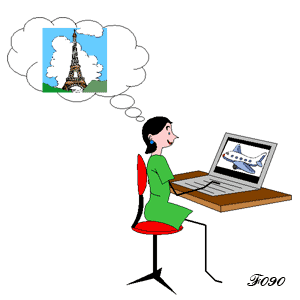

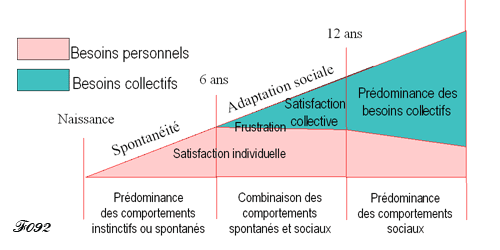
On the other hand, during their physiological maturation, these neuronal circuits are organised in such a way as to retain the possibility of choice... It will thus be possible to choose between permission and inhibition, between instinct and social adaptation, or to combine all these parameters.
The functioning of intelligence cannot be dissociated from its physical supports, just as it cannot be exercised outside a real environment. Intelligence evolves at the same time as the cells which are at its origin and the matter which serves as its support.
Thus learning takes place not only during the day, but also at night, by repetition and reinforcement of learning during the training sessions that constitute dreams.

b - Importance of the frontal cortex in the development of the child :
We now know that certain areas of the conscious work space are very quickly operational in the newborn. For example, as early as three months of age, his right prefrontal cortex becomes active when he hears his mother tongue spoken, while other groups of brain cells react to their environment and continue to mature.
Already,"something in him" that we do not understand is interested in his environment, can explore it, understand it and exploit it.
Thus, even if it is not yet expressed in words, the consciousness of the newborn seems to pre-exist language. However, this is referred to as an unconscious mechanism because the areas of language that have been developed do not yet allow the child to reproduce what he or she may have been aware of.
During this maturation, the frontal cortex will play an essential role in controlling the child's behaviour for its adaptation to life in society.
Researchers (University of Washington) have now been able to establish correlations between the age of individuals and the way in which the activity of neurons in their brain is distributed.
hus, the connections between distant regions of the brain increase, while those linking neighbouring regions decrease. It is around the age of 22 that the brain shows the characteristic organisation of an adult brain.
Its organisation will determine the installation of social integration by renouncing individual prerogatives.
3 – Social development of the child and the appearance of language : (continued)
We have envisaged that the perceptions of the foetus, before birth, may reappear in NDEs, where the adult subject contacts a universal, fusional love... They also seem to reappear in certain states of "vacuity" induced by meditation in which welcoming listening, without judgement, replaces permanent reflection.
Even if it is not conscious in the sense that we understand it, the baby certainly has perceptions of itself and, through maternal hormones, perceptions of what its mother is feeling or experiencing.
It is at birth that he will experience a major event : his whole environment will change. Separated from a world in which he lived in a state of fusion, he will have to reorganise all his perceptions and discover his place in a world that is so different from his own.

Thanks to vision, he will then apprehend the outside world and distance, which will gradually enable him to distinguish between himself and the world and then between himself and the other... After having become aware of the other and his appearance, he will become aware of his own appearance.
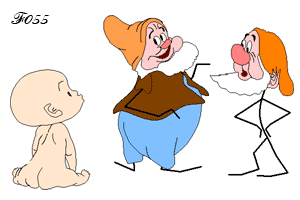 |
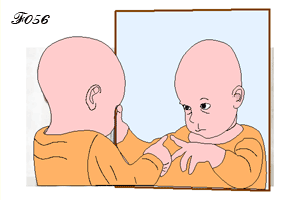 |
Baby discovering faces. |
Baby discovering his face. |
2 - Development of the child's abilities :
A – From birth to one year - discovery of the environment and imitation :
a - Imitation :We know that there are mirror neurons in the brain that are activated in the same way when the child sees or reproduces the gesture observed.
As soon as the baby is able to see, it will demonstrate its imitation abilities. Thus, from birth, and after only 42 minutes, it shows itself capable of imitating a facial expression : in doing so, it demonstrates its ability to perceive the similarity between its face and that of another.
In the early 1980s, the work of Andrew Meltzoff, a child development psychologist at the University of Washington, showed that infants have an innate ability to recognise that another person is similar to them : they can therefore reproduce the expressions of the face facing them.
Imitation tests by psychologist Andrew N Meltzoff. |
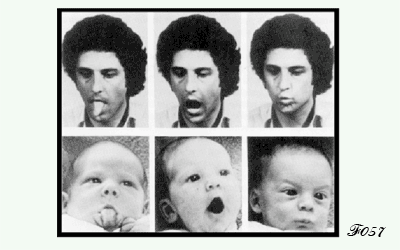 |
If you stick out your tongue, he will stick it out. If you open your mouth wide, he does the same.
Already, thanks to this capacity for resonance, a whole part of the future adult's personality is being established. Indeed, every normally constituted person resonates with others. This is how the adult confronted with expressions of anger towards him or her will feel the need to react in the same way. This is not the same as empathy, because empathy allows us to feel without experiencing the same anger or resentment.
In babies, this ability to reproduce the movements or expressions of those around them is not intentional, but automatic : this is called motor resonance (in french).
Another form of resonance is found in the field of emotions: when an infant cries in a maternity ward, the other newborns also start to cry. |
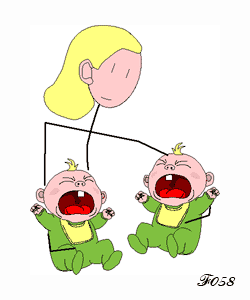 |
Babies, on the other hand, do not react when they hear the complaints of a small chimpanzee ; we can therefore assume that they already know how to identify with another baby when it cries, or with an adult when it imitates its mimics.
Similarly, they do not react when they listen to their own recorded cries. Emotional resonance is therefore only between oneself and the other.
At two months, for the perception of faces, the infant activates the same region in the right hemisphere as the adult : the right fusiform gyrus and the inferior occipital cortex.

From the age of three months, the language areas located in the left hemisphere are activated when listening to sounds and stories.
Thus, soon after being able to recognise expressions on faces, the infant will start to establish a link between what is shown to him (objective reality) and what is verbalised (virtual reality). Vision and hearing will coordinate to enable communication.
At four months of age, the child knows that an object continues to exist when it disappears from the visual field. However, he expects the object to reappear where it disappeared.

b - Emotions :
Paul EKMAN, professor of psychology at the Department of Psychiatry of the University of California, has listed the following elements to determine the basic emotions.
For him, each one must :
- be associated with triggering events,
- appear spontaneously, quickly,
- be evaluated automatically,
- be expressed by physiological changes,
- involve specific images, thoughts or sensations,
- be present not only in humans but also in other primates.
All these criteria enabled him to retain only six basic emotions, each associated with a facial expression : surprise, joy, sadness, anger, disgust and fear
These six basic emotions have, of course, been identified regardless of human group or culture.
The newborn baby is also capable, within hours of birth, of reacting to different adult emotions and of displaying its own emotional reactions.
The precociousness of this behaviour, which is not the result of learning, shows that the expression of these emotions seems to be innate.
Charles Darwin, in 1872, had already tried to find out whether human facial expressions were dependent on cultural influences or whether they were determined by biological factors. For him, not only was the expression and perception of emotions innate, and universal, but the way in which faces express anger, fear or disgust was identical in hominids, such as humans and apes.
Thus emotions, because of their precociousness and their presence equivalent to a universal language, indicate that before being designed to reason, the human brain is designed to act, with the emotions it arouses serving to transmit information for this purpose.
How do these emotions develop ?
When we observe newborns imitating their surroundings, the first question that arises is : do newborns feel what they are expressing ?
We then observe that, as early as six weeks, babies unanimously react negatively to the "stillface" test (impassive, fixed face, even smiling).
Indeed, if the eyes do not react, it is not a smile of joy or pleasure, but a smile of convenience that can be found, for example, in the field of sports dancing where it is important to give the illusion of pleasure.
When the mother is shifted in this way, babies always show eye avoidance and emotional upset. Conversely, if the smile is natural, the two-month-old baby reacts with a smile, proof that it is neither imitation nor chance. He knows how to recognise the real from the fake.
It is therefore at this age that the true function of communicating emotions appears.
Later, between four and six months, the whole body will participate in the emotion.
Finally, between nine and twelve months, the baby begins to understand that facial expressions convey information about the context. The child will then rely on the mother's expression to explore the environment.
« By the end of the first year, the child uses gestural communication to learn
and guide its behaviour. »
and guide its behaviour. »
c - Calculation :
Jean William Fritz Piaget, and Szeminska considered that the concept of number is acquired in the child around 6 or 7 years, with the acquisition of the notion of conservation.
In 1992 Karen Wynn developed an experimental procedure based on babies' interest in novelty, the habituation paradigm. She was able to show that at around four months of age, they show rudimentary numerical abilities.
d - Attitudes :
At around 4 to 6 months, the baby identifies attitudes and behaviours that differ between people. This differentiation is the first step in his own identification with others.
He is thus able to spot emotional reactions even before recognising each person individually.
This is different from the adult who recognises appearance before emotional expression.
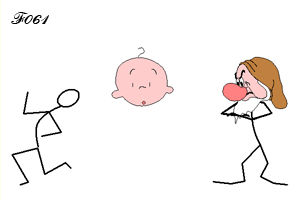 |
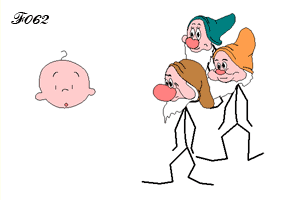 |
Recognition of the emotional reaction. |
Recognition of individuals. |

Differentiation between familiar (parents) and strangers.

« At birth, the baby has all the senses that allow access to consciousness. »
« From birth to one year, the child discovers the other and imitates him. »
B –One year to 6 years
a – Time :We have seen that before the age of one, a child looks for an object where it is at the beginning, even if he has seen an experimenter change its place. He then recognises an object fixed in the present moment : his memory does not yet allow him to situate this disappeared object in the past.

It is only from the age of one that he will discover that the same object can change place. He will thus learn that things are not immutable.
He then begins to correct his error of location, which also corresponds to the integration of a new data in the cerebral functioning : the chronology.
Indeed, the change of position of an object implies, in addition to the integration of the notion of space, that of the notion of time. There is before and after. The two are not identical.
The object can be there or elsewhere, but never there and elsewhere at the same time. Between the two, there is the memory of the object's previous place.
The memory, which was previously content to store new information, will now organise itself to fix in a data bank the events or objects that no longer exist in the present.
A piece of information perceived and fixed at the beginning (the object is on the table) will be erased while another piece of information, secondary at the beginning (the object was put on the chair) will be reinforced..
The memory begins to structure the unfolding of time : it expresses another past time that is not in contradiction with the present, but completes it.

This mechanism shows the appearance of a new function which consists of inhibiting a certainty (the object is there) to situate it in another time (it was there): this corresponds to the beginning of the maturation of the prefrontal cortex and the structuring of its memory which passes from analogical processing to cognitive processing [cf : Les prémices de la conscience / La mémoire-(in French)].

Observation and memorisation of an object.

Inhibition of the old image by the frontal cortex.

Structuring of memory.
b – Calculation :
In this area, performance is improving, but he still makes mistakes, such as confusing length with number when estimating a quantity.
He estimates that there are more chips (tokens) in the longest row. |
 |
c - Differentiation and self-awareness :
Around 18 months, the child is able to distinguish himself from others. After having learned to reproduce their gestures and their mode of communication, he discovers that he can also have an effect on his environment.
But let's take a closer look at what happens during this period.
Before birth, the child's consciousness was dependent on its own perceptions : first of all, those of contact, but also those of the distant world that reached it from outside the uterine wall (digestive sounds) or from outside its mother's body (music). In this way, he had learned to differentiate between pleasant and unpleasant sounds (soft music lulls the mother and child to sleep, screams that stress the mother also disturb him), but he had certainly not been able to understand their origin.
The outline of consciousness developed during pregnancy, from the four senses preceding the use of vision, has forged an archaic personality dependent on the immediate environment.

After birth, the use of sight will enable him to discover the world at a distance, and to structure himself by differentiating himself from the surrounding world.

Indeed, the acquisition of vision gives the necessary distance for identification, and the coordination of the different senses will make him aware of his existence (there is the other, I see him, hear him and can touch him, and there is me, I feel myself, I hear myself speak, and I can touch myself).
18 months marks a new stage in the child's development.
While the child has come to know its parents before 18 months, its personal identification is not yet complete.
Thus, children under 18 months of age, when placed in front of a mirror, touch it or try to see the figure that appears to them through the glass. It is beyond this age that the child, having grasped what a mirror is, recognises his own image in it.
He has begun by discovering the surrounding world, then discovered the other, and what differentiates him from it. He now distinguishes himself from others : his individuality is transformed into social identity.
He passes through the stage of self-awareness. |
 |
« At 18 months the child has all the elements
that enable him to assimilate social learning. »
that enable him to assimilate social learning. »
d - Empathy :
14 to 18 months :
The child's ability to imitate will be coupled with another ability, that of feeling what the other person is feeling : this is what is called empathy... The child now perceives this subtle nuance : although others are people like him, they are different and do not necessarily want the same things.
Thus, before the age of 18 months, if the child thought that his parents had the same desires and tastes as him, his social maturation will now allow him to offer them the food they like, even if this choice does not correspond to his own tastes.
Empathy replaces resonance. By enabling the child to distinguish between what others and the child feel, it is seen as a key element of development.
It requires differentiation from others and reveals an awareness of one's own identity, different from that of the other. Thus, the child has become capable of perceiving the pain of the other, but without suffering like him !
What the other person feels and expresses through their attitude or facial expression will activate their mirror neurons and enable them to feel: gesture and perception are closely linked.
The child now possesses this link that many adults have lost [cf : Intuition] (in french).

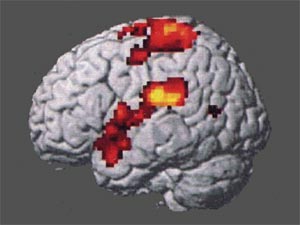 |
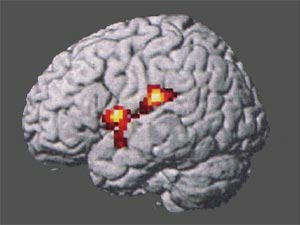 |
Perception of one's own pain. |
Perception of other people's pain. |
With empathy, a whole set of emotions and social behaviours develops: comfort, shame, pride, help, distrust, guilt... It indicates the maturation of the functions of the frontal cortex in relation to the social environment.
Empathy is important for life in a hostile environment, where it is necessary to protect oneself, and it is equally important for life in society, because it leads to helping others.
This mechanism will take almost four years to become functional. During this period, the child will explore his or her relationship with others and refine his or her perception of the interiority of others.

The maturation of emotions continues :
At around four to five years of age, the child knows that one can feel emotions and not show them or, conversely, that one can be betrayed by one's facial expression.
He then moves from imitating mental states to manipulating them.
As he grows older, he learns to inhibit spontaneous emotional responses, and to become less natural. Paradoxically, the more he enriches his emotional capacities, the less he will share his emotions.
f - Language :
We have seen that even before understanding abstract language, the child is able to understand body language. The general attitude and facial expression therefore appear to be the first elements of language before words replace the image.
We also know that the effort of attention can only be focused on one event at a time [cf : the work of consciousness during the awakening (in french)].
We can therefore already imagine that with the appearance of verbal language, the child could forget the visual expression and, sometimes, no longer take it into account [cf : Intuition (in french)].
Thus, the learning of verbal language could be the first step of the little man towards the loss of the understanding of body language... as, later, the adult could lose the understanding of his dreams [cf : REM sleep and language (in french)].
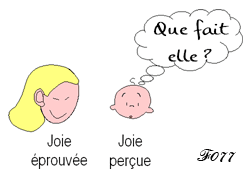 |
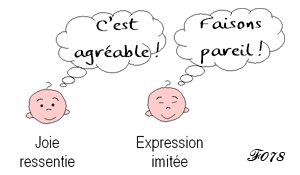 |
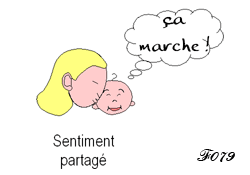 |
Perceived joy... |
...can be shared. |
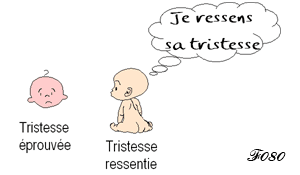 |
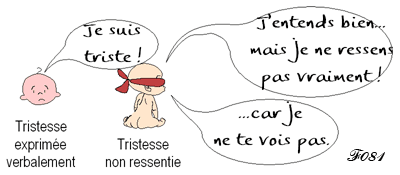 |
If the face that expresses a feeling provides a similar emotion… |
…the words establish a distance between the expression and what is felt. |

Development of the child's abilities between 0 and 6 years.
C - 6 to 12 years old :
a - Inhibition :This is when a new stage in the child's developmental process takes place, which will allow him to integrate even more closely into the human family, with consequences for his individual developmentl...
During this period, the child's individual mode of functioning in relation to the environment begins to be repressed. The "age of reason" begins to take hold.
Generally speaking, whereas in the previous period certain areas of the cortex became thinner, indicating the suppression of cells that had become useless, other areas will now predominate (prefrontal cortex) and become thicker.
This is how we can observe the thickening of the grey matter in the so-called "associative" areas of the prefrontal cortex, the superior temporal cortex and the parietal cortex, which manage the higher cognitive capacities.

The associative cortex is represented by all the areas that link the specialised areas : language, vision, motor skills.

Inhibition increases with social adaptation.
b - Numbers :
- At age 6, the child acquires numbers (according to Piaget) : he moves from innate perception to abstract calculation.
This acquisition cannot take place without inhibition : in fact, in order to carry out measurements, the child must first inhibit his innate perceptions.
Numbers, in their multiplicity, dissociate the child from his natural capacity to evaluate quantities, a capacity that we find in primitive peoples who know how to count from one to three, the higher numbers being limited to the notion of « many ».
Recognition of the environment is refined : the child becomes able to inhibit erroneous perceptual strategies, such as deducing that a row of chips (tokens) contains more chips if it is longer..
He now recognise that two rows contain the same number of chips (tokens) even though they are different lengths. Moves from "estimating" a value to "calculating" that value.

Before age six : estimates that there are more chips in the top row.
After age six : determines that both rows have the same number of chips.
After age six : determines that both rows have the same number of chips.
It is interesting to note that the acquisition of precise numbers occurs at the so-called 'age of reason', i.e. when social learning begins to take hold, learning based on logical reasoning and not on sensory perception.
This shows the importance of the maturation of the prefrontal cortex, the seat of logic and behavioural control, in spotting errors and escaping influence.
It is therefore not surprising that this infantile immaturity of the brain, which can persist in adults, is used by shopkeepers who offer, for example, four chocolates in a large box (if the box is large, it must obviously contain more!).
It is also around this age that the child begins to inhibit beliefs that have arisen in the previous period, such as the belief in Father Christmas.
The existence of such a belief indicates that the child's intuitive knowledge of the world has already been modulated and directed by adult knowledge or beliefs.
Thus, its ability to inhibit perceptual or learned misguided strategies can be detrimental when used to inhibit effective innate strategies (e.g. eating when hunger is perceived) in favour of strategies determined by manipulation.
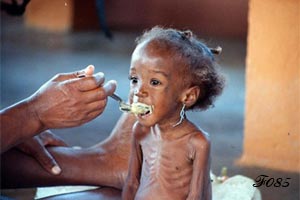 |
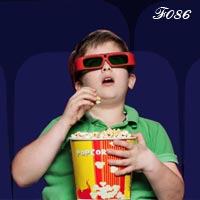 |
« I eat because I am hungry. » |
« I eat because I'm at the movies. » |
Inhibition is therefore in itself a device that favours a given reaction, but it will only be positive if the information delivered is proven, if sensitive perception is preserved and if the capacity for choice is preserved.
Intelligence cannot be properly expressed without these criteria.
If these criteria are respected, this inhibition mechanism will allow the child to enter the adult social world. Learning, spontaneously guided by curiosity and daily discoveries, will gradually be replaced by directed learning.
« The child is programmed for reality.
The acquisition of language will broaden their (his) awareness,
but will adults always impart knowledge based on reality ? »
The acquisition of language will broaden their (his) awareness,
but will adults always impart knowledge based on reality ? »
D - From age 12 to adulthood :
a - Inhibition :The trend observed previously in the development of the brain is reversed : the grey matter now thins in the associative areas: what is important is no longer the number of neurons (grey matter) but the links that are established between them (white matter).
At the same time, there is continuous growth of the cerebellum which is involved in complex learning
The maturation of the prefrontal cortex (which we have seen underpins the processes of control and inhibition) persists into adulthood.
From the age of 12 onwards, the processing of information, which had been mainly concerned with objects, will also involve ideas, hypotheses and logical propositions.
The child penetrates more and more deeply into the world of abstraction : the concrete world explored during early childhood fades away in favour of mental elaborations.
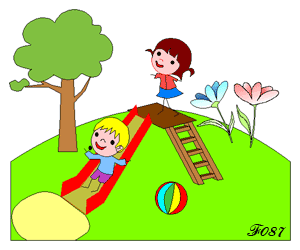 |
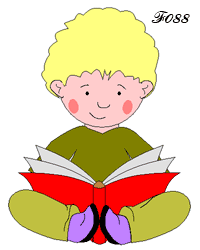 |
 |
The child begins to use hypothetical-deductive reasoning ("if"... "then"), which is made possible by neuronal circuits located in the frontal and temporal regions : from a hypothesis, he or she can deduce a new behaviour. However, if the hypothesis is the 'sine qua non' condition for reaching a new conclusion, it is equally essential that it does not conflict with the objective reality that characterises the behaviour of our primitive brain.
Thus, in the adult, we see this mental elaboration mechanism evolve and amplify. It is carried to its paroxysm and can become uncontrollable outside of any proven cerebral pathology, for example in traders who calculate virtual profits, having lost all sense of reality, whether it is economic or dependent on their real needs.

Hiking and travel arrangements are a reality.

The race to satisfy fictitious needs escapes reality.

Development of needs from birth to adulthood.
On the other hand, during their physiological maturation, these neuronal circuits are organised in such a way as to retain the possibility of choice... It will thus be possible to choose between permission and inhibition, between instinct and social adaptation, or to combine all these parameters.
The functioning of intelligence cannot be dissociated from its physical supports, just as it cannot be exercised outside a real environment. Intelligence evolves at the same time as the cells which are at its origin and the matter which serves as its support.
Thus learning takes place not only during the day, but also at night, by repetition and reinforcement of learning during the training sessions that constitute dreams.

« The spontaneity that comes from instinct
cannot be replaced by mental elaborations alone.»
cannot be replaced by mental elaborations alone.»
« Spontaneity and mental elaborations must function in parallel. »
b - Importance of the frontal cortex in the development of the child :
We now know that certain areas of the conscious work space are very quickly operational in the newborn. For example, as early as three months of age, his right prefrontal cortex becomes active when he hears his mother tongue spoken, while other groups of brain cells react to their environment and continue to mature.
Already,"something in him" that we do not understand is interested in his environment, can explore it, understand it and exploit it.
Thus, even if it is not yet expressed in words, the consciousness of the newborn seems to pre-exist language. However, this is referred to as an unconscious mechanism because the areas of language that have been developed do not yet allow the child to reproduce what he or she may have been aware of.
During this maturation, the frontal cortex will play an essential role in controlling the child's behaviour for its adaptation to life in society.
Researchers (University of Washington) have now been able to establish correlations between the age of individuals and the way in which the activity of neurons in their brain is distributed.
hus, the connections between distant regions of the brain increase, while those linking neighbouring regions decrease. It is around the age of 22 that the brain shows the characteristic organisation of an adult brain.
Its organisation will determine the installation of social integration by renouncing individual prerogatives.
« To be reasonable is to be able to inhibit spontaneous behaviour. »
3 – Social development of the child and the appearance of language : (continued)

